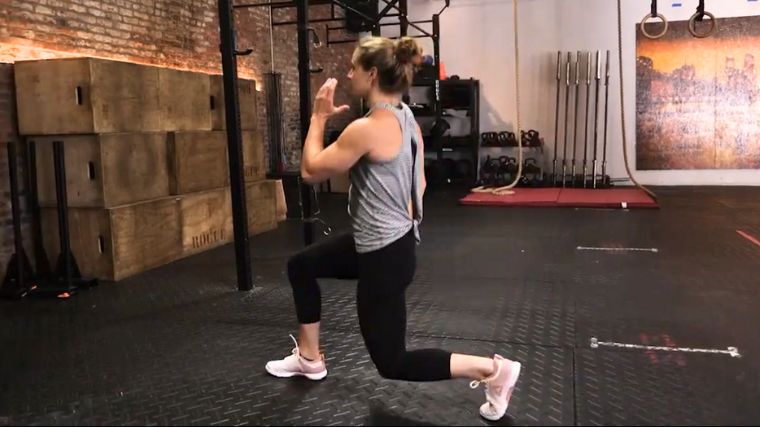A marathon is a grueling event. They last for hours and take a strong mental and physical toll. The repeated impacts from your strides inevitably add up and the next day you’ll be sore like nothing else. One of the greatest assets to survive training and thrive on game day is to weave strength training into your marathon preparation.
Strength training in combination with marathon preparation is called cross-training. It is the blending of multiple exercise styles to provide more well-rounded gains. Marathoning clearly targets your cardiovascular system but also draws on the strength and durability of your muscles.

As the event wears on, how strong you are plays a role in maintaining clean running technique and resistance to fatigue-induced errors. There are some much-needed methods of structuring your cross-training to best benefit your running performance. Here’s how to cross-train for marathons.
Editor’s Note: The content on BarBend is meant to be informative in nature, but it should not be taken as medical advice. When starting a new training regimen and/or diet, it is always a good idea to consult with a trusted medical professional. We are not a medical resource. The opinions and articles on this site are not intended for use as diagnosis, prevention, and/or treatment of health problems. They are not substitutes for consulting a qualified medical professional.
Cross-Training Explained
Cross-training is a style of exercise that combines several different training modalities or goals within the same program. Cross-training often exposes you to challenges and adaptations that fall outside of the most obvious needs of your goals.
An easy example: you may aim to improve your aerobic workouts and fitness during a program designed to improve your deadlift one-rep max. Another instance of cross-training is strength training for marathon running.
[Read More: How Do You Stack Up? Here Are the Average Marathon Times for Different Types of Runners]
In this case, the majority of your training program will place the marathon at the top of your to-do list. However, you’ll integrate structured strength training days into the program, too. Unless you’re a serious CrossFitter or hybrid athlete, this doesn’t mean performing a complete strength program simultaneously. Instead, you’ll use strength workouts to improve your performance during training or the marathon itself.
How to Approach Cross-Training for Marathon Runners
Cross-training for marathon runners should target the full body, aim to build strength, and help reduce the risk of overtraining or overuse injuries. The program still emphasizes sound marathon training but strategically chooses exercises, sets, repetitions, and exercise order to best prepare your body for the rigors of distance running.
Strength Training
Strength training exercise selection, sets and reps, and training frequency play a huge part in getting the most out of your cross-training sessions.
Exercise Selection
Exercise selection during your strength training workouts spans anywhere from low-impact or bodyweight exercises to high-impact and multi-joint movement patterns. Strength training should address all major muscle groups, build strength and resilience, and manage imbalances.

While runners certainly won’t want to neglect their upper body, a majority of exercises may be focused on their lower body and core.
Some of the best leg exercises for runners include:
These are movements that improve both strength and mobility simultaneously. They’ll also help make you much stronger on both sides, helping you to iron out any imbalances that may come naturally from side dominance like being right- or left-handed.
Some of the best core exercises for runners include upper body involvement to build strength across your whole body. They include:
- Dumbbell Z-Press
- Copenhagen Plank
- Kneeling Cable Crunch
Sets and Reps
Sets and repetitions should be conservative. There is a difference between stimulating the gains you need and completely overshooting. Remember, cross-training in this case is meant to benefit your marathon running — not necessarily make you the best strength trainer ever.
Choosing a moderate number of sets for each exercise, and balancing repetitions toward moderate strength gain is the goal. This looks like sets of five for major movement patterns such as squats or deadlifts, and sets of 10 to 12 for smaller exercises like quad extensions or hamstring curls.
[Read More: Weightlifting Training for Distance Runners]
Training Frequency
Training frequency greatly impacts how your workouts are designed, but also has a natural limit. Since cross-training has you target multiple goals or adaptations at once, there is only so much time in the week to work.
Marathon programming monopolizes the bulk of your time, so a realistic workout frequency of twice per week is reasonable. Any more volume than this, and you might eat into your recovery needs.
Exercise Order
Many distance runners prefer to do their running and strength training on different days. If this sounds like you, make sure you’re not doing a heavy lower-body workout the day before doing a particularly grueling running session. Instead, plan your intense leg days the day before scheduled active recovery runs.
Other athletes train for strength and cardio on the same day. In that case, do your running workouts before your strength training. Since running is your main priority during marathon training, you’ll want to do you runs with the most energy you can.

[Read More: The Best Treadmills for Your Home Gym (Expert Tested)]
On the other hand, strength athletes generally train strength first, and then do their cardio. It’s all about what your priorities are. For marathoners, give your running most of your energy and focus. Just make sure you’ve got enough energy left to perform your strength workouts with great form.
Cross-Training Workout Plan for Marathon Runners
Cross-training workout planning for marathon runners restricts many athletes to about two sessions in the weight room per week. That’s because you’ll need to preserve energy for recovering from your runs and keep the focus on your endurance training.
[Read More: How to Strength Train for Your 5K (and Why You Should)]
Don’t worry, though: two solid strength workouts per week should be more than enough to get marathoners nice and strong. If in doubt, check with a running coach to evaluate how much volume you might be able to handle — but listen to your body if you’re feeling the need to scale back. Start small, and build up from there.
Day 1
On day one, you’ll work on balance for the postures and muscles you constantly use while running. Choosing less stable exercises and unilateral variations helps to accomplish a ton of goals at the same time. These unilateral exercises mimic the unilateral nature of running in a way that can help you strength your muscles and potentially decrease your risk of injury.
[Read More: What Are Cross-Training Shoes? How to Pick the Best Pair of Cross-Trainers for You]
Goblet front-foot elevated split squats and walking lunges are both fantastic for evening out any strength and mobility imbalances between your leg muscles and hips. The dumbbell Z-press and pull-ups integrate your core and shoulder stability, and the Copenhagen plank scorches your adductors and obliques. Don’t forget your calf and toe raises — they help stave off some of that nasty soreness from long runs by strengthening your calves and feet.

[Read More: 12 Best Cross-Training Shoes (Personally Tested)]
- Goblet Front-Foot Elevated Split Squat: 2 x 10 per leg; tempo 2-1-1-1
- Dumbbell Z-Press: 2 x 12
- Pull-Up: 3 x AMRAP*
- Walking Lunge: 3 x 10-12 per leg
- Toe Raise + Calf Raise**: 2 x 15 per exercise; 1-count pause, fully contracted
- Copenhagen Plank: 2 x 20 seconds per side
* AMRAP = as many reps as possible
** Perform these as a superset.
- Make it Easier: Use a pull-up assist band to help with your pull-ups, or perform jumping or scapular pull-ups. Use your body weight for the split squats, toe raises, and walking lunges if you’re not ready to load them up with dumbbells.
- Make it Harder: Use a 3-1-2-1 tempo for each of your exercises (aside from the Copenhagen plank).
Day 2
Day two similarly includes unilateral exercises to keep your joints working through their full ranges of motion independently. The goal here is to prevent or offset any growing compensations or imbalances during your runs.
B-stance dumbbell Romanian deadlifts and half-kneeling single-arm cable pulldowns will work your hips, back, and core, while the cable crunch keeps you flexible and not super rigid through the torso. Your floor and cable pressing help to build upper body strength while promoting shoulder stability.

[Read More: How Tempo Training Can Progress Your Workouts]
- B-Stance Dumbbell Romanian Deadlift: 2 x 10 per leg; tempo 2-1-1-1
- Dumbbell Floor Press: 3 x 10
- Half-Kneeling Single-Arm Cable Pulldown: 3 x 12 per side
- Cable Chest Press: 3 x 12
- Toe Raise + Calf Raise*: 2 x 15 per exercise; 1-count pause, fully contracted
- Kneeling Cable Crunch: 2 x 12; full exhale per repetition
* Perform these as a superset.
- Make it Easier: Perform your Romanian deadlifts with a conventional stance instead of a B-stance. Do your single-arm cable pulldowns from a seated position instead of half-kneeling.
- Make it Harder: Use a 3-1-2-1 tempo for each exercise.
Balancing Running and Strength Training
Using cross-training to combine marathon running and strength work is a solid strategy to improve your performance. There are a few key points to consider to best plan your workout program. In this case, you’re looking for strength training to help your marathons, so you’ll only have so much time — and recovery is priority number one.
Running First
The benefits of cross-training extend beyond combining strength for marathon running. For example, interval training is a great way to work your aerobic capacity during muscle building. Whichever type of cardio you’re doing, strength training is — when you’re training for a marathon — the supplementary approach. Your run training is foremost.
[Read More: How to Run a Faster Mile, According to a Running Coach]
This means designing your strength workouts around maximizing running performance and not emphasizing peak strength development. You won’t need to be a powerlifter to see marathon gains, but executing the basics extremely well pays off massively. So, get your runs in first, when you have the most energy mentally and physically.
Efficient Programming
Given the intensity and frequency that marathon programming already requires, adding in strength workouts as a form of cross-training leaves you with little wiggle room. Once you have mapped out your running workouts, it becomes clear exactly how much and where you might be able to sneak in your strength training.
[Read More: Different Types of Strength Training (+ How to Get Started)]
This likely means fewer, shorter, but highly efficient strength workouts. One hour two times per week is a good starting place, with the workouts peppered in on the same day as easier runs or on rest days. In any case, you’re not looking for a complete strength program — just a sample of the essentials to peak your marathon performance.
Recovery
Recovery is the single biggest factor in designing your cross-training for marathons. Overtraining, overuse injuries, or simple burnout are big things to be mindful of. Since you have minimal space for strength training, each session should generally be a full-body workout. Between your warm-up, upper-body and lower-body compound movements, and core strength exercises, you’ll be looking for your bed in no time.
[Read More: The Best Supplements for Runners]
Map out your entire training week in advance, including blocked-off time for recovery (for example, extended periods of sleep and when you’ll be eating). Weaving these factors directly into your training program is a great way to stay ahead of any risk of overtraining and to stay injury-free.
Benefits of Cross-Training for Marathon Runners
Cross-training for marathon runners is a great way to fill in some gaps that may form from exclusively running. Improving your durability in long-distance running, balancing out any overemphasized muscle groups, and enhancing start or finish speeds are great perks of cross-training.
Durability
Strength training is particularly effective at building the physical resilience or durability of your muscles. Strength training helps to build your muscles, bone mineral density, and the resilience of your connective tissue. While marathon training focuses on running economy, heart rate, and overall cardiovascular performance, your strength training should help build up your strength and durability.
Muscle Balance
Getting good at any style of training inevitably causes you to skew your abilities in a specific direction. Getting good enough at running to participate in marathons likely means a certain complement of muscles is going to slowly start to dominate.
[Read More: So You’re Jogging More Than Ever – Here’s How to Maintain Muscle Mass]
Strength training helps to offset how much emphasis you put on your running stride and allows a healthier balance of physical abilities. Cross-training for runners won’t cancel out the specific pattern of muscle or cardio development needed to excel at marathon running — but it helps prevent those adaptations from running away with you.
Burst of Speed
You’ll need to build your muscular strength if you want to give yourself a starting and finishing burst of speed. Strength training workouts primarily call upon immediate energy systems that are very anaerobic (don’t use oxygen). Immediate energy stores greatly contribute to strength training.

[Read More: What Is Fartlek Training? Get Faster With This Method of Cardio Training]
By simply performing a well-programmed strength training workout, your higher-intensity energy systems and physical abilities get a boost. Not only does this help with overall muscle balance and offsetting wear and tear, but you’ll also train your body to kick up the pace on a dime to bust out some speed when you need it most.
Cross Train for Multiple Gains
For both beginners and advanced runners, if you’re aiming to run a marathon, you’ll want to get stronger to be a better runner. Cross-training improves the strength and durability of your muscles. You only need to do it a couple of times a week — focusing on full-body compound exercises — to give yourself some hefty benefits.
A few quick and effective strength sessions per week help improve your durability, muscle balance, and even give an added kick to your burst of speed. Plan out your runs and recovery first, but sneaking in some crucial strength training sessions makes all the difference in peak marathon performance.
FAQs
Cross-training is a highly effective tool for training for both endurance and strength. Here are some frequently asked questions about this concurrent training plan.
Cross-training activities like compound exercises — for your lower and upper body as well as your core — can help with strengthening your muscles and potential injury prevention. Work your glutes, quads, and hamstrings with weighted lunges and squats. Give your upper body and core some love with push-ups, cable crunches, and dumbbell Z-presses.
The goal of strength training for marathons is to get stronger to support your marathoning. You aren’t strength training to be a master weightlifter — but rather to help improve your training, performance, and recovery for marathons.
Prioritize big full-body compound exercises such as squat or lunge patterns, hinges, and pressing. Be very conservative with how much volume and high-intensity lifting you perform. Aim for highly efficient, full-body workouts to build strength, and then recover with lots of food and sleep.
Compound (multi-joint) exercises stand out as some of your best options for strength training as a runner. This is because they help improve full body strength with the best bang for your buck time-wise. Pepper in unilateral work (training one side of your body at a time) as well to help maintain mobility, range of motion, and stability.
Some of the exercises that fit this bill are walking lunges, Copenhagen planks, split squats, Z-presses, floor presess, calf and toe raises, and kneeling cable crunches.
The post How to Do Cross-Training For Marathons, With a Strength Workout Plan for Runners appeared first on BarBend.

